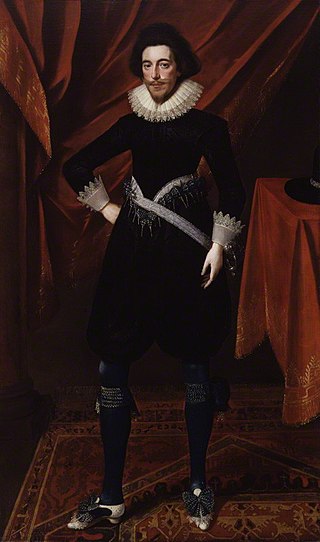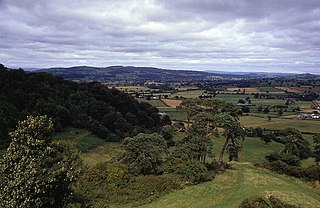Related Research Articles
The Battle of Lostwithiel took place over a 13-day period from 21 August to 2 September 1644, around the town of Lostwithiel and along the River Fowey valley in Cornwall during the First English Civil War. A Royalist army led by Charles I of England defeated a Parliamentarian force commanded by the Earl of Essex.

1644 (MDCXLIV) was a leap year starting on Friday of the Gregorian calendar and a leap year starting on Monday of the Julian calendar, the 1644th year of the Common Era (CE) and Anno Domini (AD) designations, the 644th year of the 2nd millennium, the 44th year of the 17th century, and the 5th year of the 1640s decade. As of the start of 1644, the Gregorian calendar was 10 days ahead of the Julian calendar, which remained in localized use until 1923.

Robert Devereux, 3rd Earl of Essex, KB, PC was an English Parliamentarian and soldier during the first half of the 17th century. With the start of the Civil War in 1642, he became the first Captain-General and Chief Commander of the Parliamentarian army, also known as the Roundheads. However, he was unable and unwilling to score a decisive blow against the Royalist army of King Charles I. He was eventually overshadowed by the ascendancy of Oliver Cromwell and Thomas Fairfax, and resigned his commission in 1646.

The First English Civil War took place in England and Wales from 1642 to 1646, and forms part of the 1639 to 1653 Wars of the Three Kingdoms. An estimated 15% to 20% of adult males in England and Wales served in the military at some point between 1639 and 1653, while around 4% of the total population died from war-related causes. These figures illustrate the widespread impact of the conflict on society, and the bitterness it engendered as a result.

The Second Battle of Newbury was a battle of the First English Civil War fought on 27 October 1644, in Speen, adjoining Newbury in Berkshire. The battle was fought close to the site of the First Battle of Newbury, which took place in late September the previous year.
Colonel John Moore (1599–1650) was one of the regicides of King Charles I.

Sir William Batten was an English naval officer and administrator from Somerset, who began his career as a merchant seaman, served as second-in-command of the Parliamentarian navy during the First English Civil War, then defected to the Royalists when the Second English Civil War began in 1648. After the 1660 Stuart Restoration, he was elected Member of Parliament for Rochester and re-appointed Surveyor of the Navy, a position he had previously held from 1638 to 1648. In this capacity, he was a colleague of the author Samuel Pepys, who mentions him frequently in his "Diary", often to his detriment.

Lieutenant-General Henry Wilmot, 1st Earl of Rochester, known as The Lord Wilmot between 1643 and 1644 and as The Viscount Wilmot between 1644 and 1652, was an English Cavalier who fought for the Royalist cause during the Wars of the Three Kingdoms.
Events from the year 1645 in England. This is the fourth year of the First English Civil War, fought between Roundheads (Parliamentarians) and Cavaliers.
The Storming of Bolton, sometimes referred to as the "Bolton massacre", was an event in the First English Civil War which happened on 28 May 1644. The strongly Parliamentarian town was stormed and captured by Royalist forces under Prince Rupert. It was alleged that up to 1,600 of Bolton's defenders and inhabitants were slaughtered during and after the fighting. The "massacre at Bolton" became a staple of Parliamentarian propaganda.
Events from the year 1643 in England. This is the second year of the First English Civil War, fought between Roundheads (Parliamentarians) and Cavaliers.
Events from the year 1646 in England. This is the fifth and last year of the First English Civil War, fought between Roundheads (Parliamentarians) and Cavaliers.

Cornwall played a significant role in the English Civil War, being a Royalist enclave in the generally Parliamentarian south-west.
1644 was the third year of the First English Civil War. The King's position continued to decline and the Long Parliament sent the Propositions of Uxbridge, an attempt to end the war, to the king at Oxford

Boy was a white hunting poodle belonging to Prince Rupert of the Rhine in the 17th century. Parliamentarian propaganda alleged that the dog was "endowed" with magical powers.

John Poulett, 1st Baron Poulett, of Hinton St George, Somerset, was an English sailor and politician who sat in the House of Commons between 1610 and 1621 and was later raised to the peerage.

The Battle of Burton Bridge was fought between Royalist and Parliamentarian forces at Burton upon Trent on 4 July 1643 during the First English Civil War. By the time of the battle, the town, which had at various times been held by both sides, was garrisoned by a Parliamentarian unit under the command of Captain Thomas Sanders and the town's military governor, Colonel Richard Houghton. The key river crossing at Burton was desired by Queen Henrietta Maria, who was proceeding southwards from Yorkshire with a convoy of supplies destined for King Charles I at Oxford. The Royalists, led by Colonel Thomas Tyldesley, launched a cavalry charge across the bridge which succeeded in defeating the Parliamentarians and capturing most of their officers, including Sanders and Houghton. The Queen's convoy proceeded on its way south to Oxford, with Tyldesley receiving a knighthood and a promotion in recognition of his victory. Burton changed hands several more times during the course of the war, before finally coming under Parliamentarian control in 1646.
This is a timeline for the English Civil War in Shropshire.

The Battle of Montgomery took place during the First English Civil War of 1642–1646. On 17 September 1644, a Parliamentarian force commanded by Sir John Meldrum advanced to engage a Royalist army led by Lord Byron which was besieging Montgomery Castle in mid Wales. The battle was fought the next day. After the Royalists gained an initial advantage, the Parliamentarians counter-attacked and destroyed Byron's army.
The siege of Lyme Regis was an eight-week blockade during the First English Civil War. The port of Lyme Regis, in Dorset, was considered to be of strategic importance because of its position along the main shipping route between Bristol and the English Channel. Thomas Ceeley and Robert Blake commanded the town's Parliamentarian defences during the siege, which was laid by Prince Maurice between 20 April and 16 June 1644.
References
- 1 2 3 Palmer, Alan; Palmer, Veronica (1992). The Chronology of British History. London: Century Ltd. pp. 179–181. ISBN 0-7126-5616-2.
- 1 2 3 4 5 Williams, Hywel (2005). Cassell's Chronology of World History . London: Weidenfeld & Nicolson. p. 260. ISBN 0-304-35730-8.
- 1 2 3 4 5 "1644, British Civil Wars". Archived from the original on 12 October 2007. Retrieved 2007-09-14.
- ↑ Lacey, Peter (2011). "Civil War". Ebb & Flow: the story of maritime Lyme Regis. Wimborne Minster: Dovecote Press. pp. 108–18. ISBN 978-1-904349-92-1.
- 1 2 Young, Peter; Holmes, Richard (2000). The English Civil War . Ware: Wordsworth Editions. ISBN 1-84022-222-0.
- ↑ Firth, Charles Harding (1922). "Rupert, Prince". The Dictionary of National Biography. Vol. 17. Oxford University Press. p. 408.
Rupert returned to Wales.. Defeating the parliamentarians at Stockport, he forced his way into Lancashire, stormed Bolton on 28 May, and captured Liverpool on 11 June.
(Quoting Ormerod, Civil War Tracts of Lancashire, p. 187). - ↑ Williams, Michael Edward; Shurden, Walter B. (2008). Turning Points in Baptist History. Macon, GA: Mercer University Press. p. 17.
- ↑ "Elisabeth Haselwood | National Museum of Women in the Arts". nmwa.org. Retrieved 10 April 2019.